
It can be quite uncomfortable to get bit by your dog while you’re trying to have a nice time. If that has happened before, we guess that has got you asking “Why is this happening?” “Why does my dog chew on me?” “Is this normal?” “Should I be worried?”
The truth is that, oftentimes, dog parents are conflicted about what to do when their pups chew on them. On the one hand, it does not hurt that much, it’s just a little shocking is all. On the other hand, you also understand that not doing anything about it would be like condoning bad behavior.
But then again, how do you nip this situation in the bud and quickly too? Do you stop playing with your dog altogether? That seems harsh and not quite what you had in mind when you went ahead to adopt your puppy.
So, what do you do?
Well, first off, you’ve asked the right question. Understanding why your dog chews on you is an important step in the correction of the behavior ultimately.
Today, we cover the why of dog chewing as well as how to correct this behavior in pets so you don’t lose your mind.
Table of Contents
Why Does My Dog Chew On Me? — The Root Of The Problem
So, first of all, it’s not called biting or chewing. If while playing with your dog, you find that your dog gently bites on your hand or any part of your body, it’s technically referred to as mouthing.
You must have noticed that when dogs play with each other, they have their mouths open and it looks like they are biting each other. Well, wrong again. They aren’t biting each other, they are mouthing.
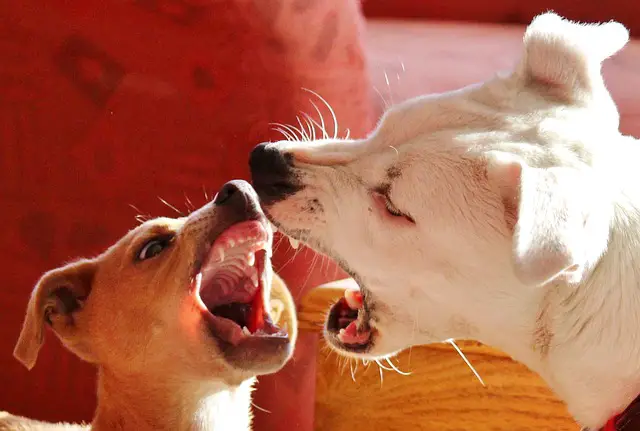
This mouthing is what allows them play with each other without injuring anybody. So, that’s the same thing they do to you when they mouth you. Since your dog considers you his buddy and y’all are playing, he’s going to carry out this behavior with you too. He doesn’t understand that this could hurt a little, especially for a human. For the dogs though, they feel nothing, at least, for the most part.
So, why exactly do dogs mouth?
Well, mouthing is your dog’s way of growing his fighting skills so that he is able to survive in the wild. By instinct, dogs know when they are just play fighting, so they don’t apply a lot of pressure then. However, depending on the breed, the bites can still hurt to various degrees.
If you’ve been bitten by a Miniature Yorkie and a St Bernard, for instance, you can confirm that they hurt to different degrees. While that of the Yorkie might simply surprise you, that of the St Bernard, on the other hand, might elicit a significant “ow!”
Generally, like we said earlier, play biting isn’t such a big deal. It’s just play, and as long as it does not graduate to aggression, you don’t have to worry. So, how can you tell?
Well, when play biting, dogs are often gentler, they look happy and might even be lying down. If aggression, on the other hand, the bite is a lot faster, the dog is baring his teeth, growling, snarling, barking, and appears tense. But, most importantly, you’ll feel it. This is the bite you want to correct.
However, since no one wants to risk losing an appendage, they want to stop the play biting altogether, and we can’t blame anyone. In fact, it’s actually wise.
Other Reasons Dogs Chews On You
Besides practicing their fighting, dogs also chew on your hand as a way to express their excitement. So while we scream, smile, dance, clap, or other stuff to express our excitement, dogs can only express this by latching on to something with their teeth.
Plus, puppies also to teach littermates and playmates boundaries and respect by play biting, pretty much like human roughhousing.
So, when you touch them, in the spirit of play biting, they might carry out such behavior again assuming that this is another playmate.
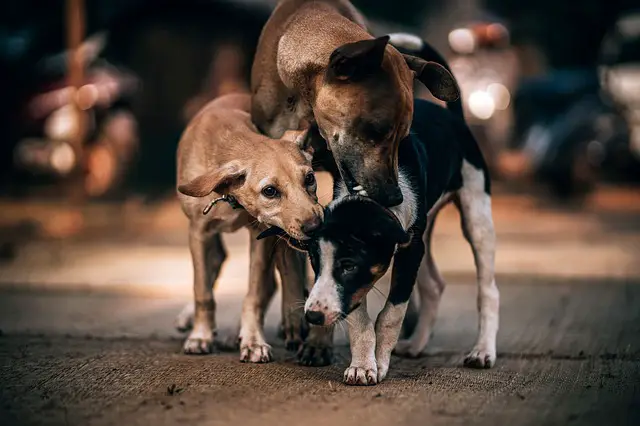
Do They Stop Biting?
Well, normally, they stop biting. So, under normal circumstances you shouldn’t be asking “why does my dog chew on me?” for the rest of your dog’s life.
Usually, puppies are introduced to play biting as a result of sharing close living space with their littermates. So, usually, once your puppy is separated from her littermates, you can begin to teach her how to stop play biting.
Generally, though, puppies naturally stop biting at around 6 months, at which point they’ve most likely understood what boundaries are.
So, on the journey to that expected day, you can keep your puppy occupied by giving her some toys that she can chew on for now because she has to.
Chewing is more than biting. It’s important that dogs are able to chew for a number of reasons as the American Society for the Prevention of Cruelty to Animals (ASPCA) have informs.
First, dogs use chewing to keep their pearly whites clean as well as a means to exercise their jaws so it remains strong and healthy. So, you find that some dogs would literally spend hours at a time just chewing on all kinds of things including toys, sticks, and bones.
Also, chewing might be your dog’s way of relaxing or easing anxiety. This is why, oftentimes, dog parents find out that their dogs chew more often when they are not around, maybe out of separation anxiety (learn more about dog separation anxiety by clicking here).
So, yeah, all this is beautiful and what not but how do I stop this behavior? Hold your horses, or in this case, your dog, we address that next.
But just before then, check out this video where Kaelin Munkelwitz clears some misconceptions about puppy nipping as well as ways to correct this behavior humanely and quickly too. She emphasizes the importance of teaching focus and self-control as well as the importance of persistence on your part.
How To Get Your Dog To Stop Chewing On You
Play biting and chewing might seem cute when your dog is still a puppy but as he begins to grow and his bites get more painful, it stops being cute. It could even get embarrassing as many of such dogs don’t understand boundaries and might even mouth or bite your guests.
Now, remember what we said about dogs’ play biting. It does not hurt their littermates and playmates. However, because human skin is more sensitive, it can cause some hurt but dogs don’t understand that. So, you’re going to have to teach him that.
You’re going to have to teach him that there’s a difference between human skin and dog skin. Therefore, he has to be gentle when playing with humans.
So, our first solution to this would be for you to teach your dog bite inhibition.
Teach Bite Inhibition
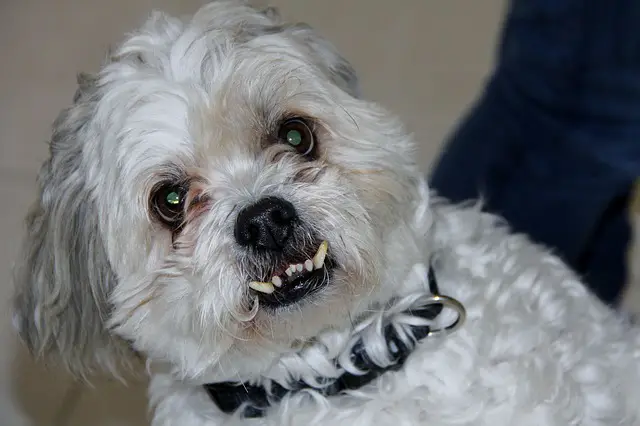
As the phrase suggests, bite inhibition is your dog’s ability to control the amount of pressure he applies when mouthing. If your dog hasn’t learned this, then he’s going to always bite hard even when he’s playing not realizing that humans have a different kind of skin.
In fact, according to some dog behaviorists and trainers, dogs who have learned bite inhibition are less likely to bite hard enough to break skin even when in a situation outside of play like when he’s scared or in pain.
Now, usually, when dogs play, as we said, they don’t feel pain. However, every now and then, someone bites too hard and there’s pain. When this happens, the one who’s been bitten would usually let out a yelp and stop playing. When the biter sees this, he is startled and sorry and then both stop playing for a bit.
Soon enough though, everyone forgets that the issue ever happened and gets back to playing as normal. You can bet, though, that a vital lesson has been passed on bite inhibition.
You’re going to have to mimic this same behavior when playing with your dog. Allow him mouth your hands until he increases pressure significantly. Then you yelp and let your hand go limp, like your hurt. Most dogs would be taken aback and let go, at least temporarily when this happens.
However, if yelping does not work, you can instead sternly say “too bad!” or “you blew it!” When he stops, if he stops, don’t forget to praise him and continue playing and repeat the process if he bites again. However, do not do this more than thrice in a 15-minute period.
Apply The Time-Out Rule
Another way to get results is by instituting a time-out whenever your dog goes out of line. This method is more effective for adult dogs, though.
So, when your dog bites hard during play, yelp loudly. Your dog will turn around to find out what happened, then take away your hand and ignore him for 10 to 20 seconds. If he begins to mouth on your hand again, leave the room for about 10 to 20 seconds, if necessary.
After the time-out, return to the room and get him to play again.
This lesson is important as it reinforces to your dog that painful play will not stop but gentle play will continue.
Now, even when your dog has started decreasing the pressure of his biting, begin to tighten up the rules a bit. Demand an even higher level of gentleness from your dog. So, even when he has reduced his bite to a moderate level, still apply the time-out rule.
Keep applying this rule until your dog gradually reduces the pressure behind his bite until you begin to feel no pressure at all.
Next Steps — Teaching Your Dog That Dog Teeth Shouldn’t Be On Human Skin
1. Get Your Dog A Chew Toy
Get your dog a chew bone or a toy so that he does not try to gnaw on toes or fingers. (Click here to read our article on safe dog toys you can get for your dog).
2. Distract
Sometimes, dogs bite on their handler’s hands when patted, stroked or scratched. If this is your dog, you might want to distract him by giving him some treats while stroking him. When you do this, he will get used to being touched without necessarily mouthing. (Click here to read our article on healthy dog treats).
3. Non-Contact Forms Of Play
Instead of contact forms of play such as wrestling and rough play, play more non-contact forms of play such as tug-of-war or fetch. Tug-of-war helps him deals with frustration and arousal. However, if you don’t want your tug-of-war play with your dog to end in tears, you must follow some rules.
So, once your dog is able to play tug-of-war safely, keep the toys for tug close to you always. So, if he begins to mouth, redirect your dog to the toy. As you continue to do this, he’ll start to look forward to his tug toy when he feels like mouthing.
This also works if your dog bites at your ankles and feet. So, the moment your dog tries to bite your dog’s feet or ankle, wave the tug toy enticingly at him and wait for him to grab the toy. Once he does this, you can keep moving.
If you don’t have the toy close to you, just stop and wait for him to stop mouthing you. When he does, praise him, get a toy, and reward him.
4. Teach Impulse Control
By teaching simple exercises such as “Wait!” “Sit!” or “Leave it!” your dog can easily learn impulse control.
5. Get Your Dog Dog-Friends
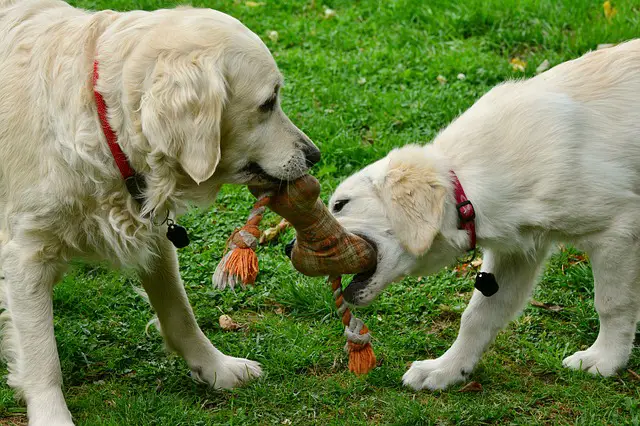
Your dog needs canine friends too. So, if you know any dog or small group of friendly, vaccinated (emphasis on vaccinated) dogs. This way, he’d expend more of his energy playing with his fellow canines and then he won’t have to be so rough when he plays with you.
6. Tweak The Time-Out Rule
You can tweak the time-out rule we shared initially. Rather than applying the time-out rule when he bites with some level of force, apply it the moment you feel his teeth on your skin even before he mouths.
So, when you feel his teeth, yelp and ignore him for up to one minute. If the behavior persists, then leave the room for about a minute. Just make sure the room you’ve left him has been dog-proofed, else he might destroy stuff.
When the time-out elapses, return to the room and resume play.
Or, you can keep your dog leashed but don’t hold it. When you feel his teeth, hold the leash and lead him to a quiet part of the room, probably behind a baby gate, and leave him there. If there’s no baby gate, you can tie the leash to something heavy. Now, turn your back on him and ignore him until the time-out has elapsed. Then you can untie or release him and resume play.
7. Taste Deterrents
Use this method if time-out isn’t working. Spray the taste deterrent on the parts of your body that your dog likes to mouth or bite. You can also spray it on clothing if he mouths on your clothing.
When he tries to mouth you, he’ll taste the awful deterrent and react to it. Stop moving until that happens. Then when he does, praise and reward him as usual.
You want to do this consistently for two weeks at least. In that time, your dog should most likely have learned to inhibit his mouthing behavior.
8. Peppermint Or Spearmint Breath Spray
This should be your method of last resort. Please only use this method if all else has failed. So, carry a small can of either Spearmint breath spray or peppermint spray with you always. When he tries to mouth you, yelp and squirt a short burst of the spray into your dog’s mouth directly.
You would want to make this action quick and smooth. Now, this shouldn’t dwindle down into a wrestling match. Plus, if you have an aggressive dog at hand, this method might not work either.
For those who don’t feel comfortable with using punishment or don’t think they can implement this fast enough, you might want to seek professional help which brings us to our final point.
9. Get Professional Help
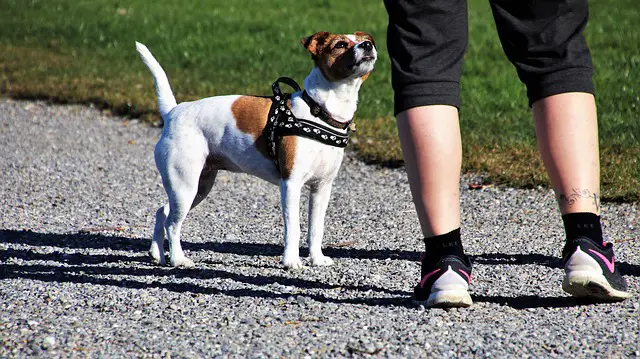
Some dogs are problematic to work with. If this is the case with your dog, then you might want to get a Certified Professional Dog Trainer known as a CPDT. Group classes or private training, whatever is better for your budget and needs, these professionals can help you nip this attitude of nipping in the bud (pun most definitely intended).
Some General Precautions To Live By
- Try not to wave your fingers or toes in front of your dog’s face in an attempt to get him to play. Don’t slap his face either. Such things will only encourage him to bite your hands and feet even more.
- Do not stop play, and this is very important. Playing is an important way in which dogs build a strong bond with their humans and their fellow dogs. The aim of correcting the biting behavior is to teach your dog to play gently and not to quit playing altogether.
- Also, never correct biting with hitting or slapping your dog, it just makes him more aggressive in his play. But beyond that, physical punishment increases aggression and instills fear.
So, no scruff shaking, no whacking on the nose or other such things. Some even stick their fingers down their dogs’ throats. What? No. that’s just wrong.
Now that you know what to do about your dog chewing on you, we hope you’re able to enjoy moments with your dog even more.

